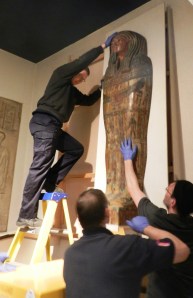Using ‘next generation’ DNA sequencing, scientists at the University of Manchester have confirmed a long-held supposition that the famous ‘Two Brothers’ of the Manchester Museum have a shared mother but different fathers – so are, in fact, half-brothers. This is the first in a series of blog posts presenting the DNA results, and discussing the interpretation and display of the Brothers in Manchester.
The ‘Two Brothers’ are among Manchester Museum’s most famous inhabitants. The complete contents of their joint burial forms one of the Museum’s key Egyptology exhibits, which have been on almost continuous display since they were first entered the Museum in 1908.

The Two Brothers’ inner coffins: Khnum-nakht (left) and Nakht-ankh (right), 2011
Central to public (and academic) interest have been the mummified bodies of the men themselves – Khnum-nakht and Nakht-ankh – who lived around the middle of the 12th Dynasty, c. 1900-1800 BC. Their intact tomb was discovered at Deir Rifeh, a village 250 miles south of Cairo, in 1907 by an Egyptian workman called Erfai – a rare case where the non-European discoverer is named. He was working for Ernest MacKay and Flinders Petrie, the British archaeologists who wrote the reports and the names people usually remember. Unusually, the entire contents of the tomb – mummies, coffins, and a small number of other objects – were shipped to Manchester, rather than being divided among different international museum collections as was usually the case.
Once in Manchester, in 1908, the mummies of both men were unwrapped by the UK’s first female Egyptologist employed by a University, Dr Margaret Murray. This procedure, which mixed both science and spectacle, set the tone for more than a century’s worth of scientific investigation, exploiting the intact ‘time capsule’-like nature of the burial.

Margaret Murray and team with the remains of Nakht-ankh, 1908
Murray’s team –namely Dr John Cameron, an anatomist – concluded that the skeletal morphologies were quite different, suggesting an absence of a biological relationship. Although notoriously difficult to age such skeletal remains, the team suggested that Khnum-nakht had been around 40 years of age when he died and that Nakht-ankh had died at around the age of 60, perhaps around a year later than Khnum-nakht (based on year dates inked onto the bandages of both mummies).

Margaret Murray’s original publication of the tomb group
Hieroglyphic inscriptions on the coffins indicated that both men were the children of an unnamed local governor (thus, they were of the elite in society) and had a mother of the same name, Khnum-aa. It was thus that the men became known as the Two Brothers. Based on contemporary inscriptional evidence, it was proposed that one (or both) of the Brothers was adopted. Up until recently previous attempts to extract and analyse DNA from the Brothers’ remains had been inconclusive.
Therefore, in 2015, the DNA was extracted from the teeth, removed by Dr Roger Forshaw, a retired dentist, and analysed by Dr Konstantina Drosou, of the School of Earth and Environmental Sciences at the University of Manchester. Following hybridization capture of the mitochondrial and Y chromosome fractions, the DNA was sequenced by a next generation method. Analysis showed that both Nakht-ankh and Khnum-nakht belonged to mitochondrial haplotype M1a1, suggesting a maternal relationship. The Y chromosome sequences were less complete but showed variations between the two mummies, indicating that Nakht-Ankh and Khnum-Nakht had different fathers, and were thus very likely to have been half-brothers genetically.
The study, which is published in the Journal of Archaeological Science, is the first to successfully use the typing of both mitochondrial and Y chromosomal DNA in Egyptian mummies.
The Brothers pose a number of questions of interpretation, which – despite much interest in them – have not been fully explored. Some of the issues concerning their display and interpretation will be examined over the coming weeks on this blog.








